List of ironclad warships of France
France built a series of ironclad warships between the 1850s and 1890s; these began with the Dévastation-class ironclad floating batteries built during the Crimean War, which presaged Gloire, the first sea-going ironclad to be built by any navy.
Broadside ironclads
- Gloire class 5,603 tons.[1]
- Couronne (1861) 5,983 tons – hulked 1910.[1]
- Magenta class 6,715 tons.[1]
- Provence class 5,700 – 6,122 tons.[1]
- Provence (1863) – stricken 1884.[1]
- Héroïne (1863) – hulked 1894.[1]
- Flandre (1864) – stricken 1886.[1]
- Savoie (1863) – stricken 1888.[1]
- Magnanime (1864) – stricken 1882.[1]
- Surveillante (1864) – stricken 1890.[1]
- Valeureuse (1864) – stricken 1886.[1]
- Gauloise (1865) – stricken 1883.[1]
- Revanche (1865) – BU (broken up) 1893.[1]
- Guyenne (1865) – stricken 1882.[1]
- Belliqueuse (French: Belliqueuse) (1865) 3,717 tons – expended as a target 1886.[1]
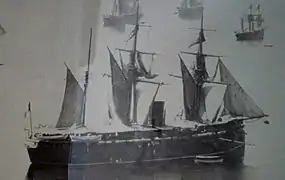 Gloire
Gloire La Gloire
La Gloire Invincible in 1860
Invincible in 1860 Couronne in 1861
Couronne in 1861 Magenta and Napoléon III
Magenta and Napoléon III.jpg.webp) Solférino in 1861
Solférino in 1861 Solférino
Solférino.jpg.webp) Guyenne class in 1865
Guyenne class in 1865.jpg.webp) Belliqueuse in 1865
Belliqueuse in 1865.jpg.webp) Normandie in 1870
Normandie in 1870
Central battery ships
- Alma class (French: Classe Alma) 3,513–3,828 tons.[1]
- Océan class 7,580/7,775 tons.[1]
- La Galissonnière class (French: Classe La Galissonnière 4,585–4,645 tons.[1]
- La Galissonnière (1872) – stricken 1894.[1]
- Triomphante (1877) – sold 1903.[1]
- Victorieuse (1875) – hulked 1900.[1]
- Friedland (1873) 8,850 tons – stricken 1902.[1]
- Richelieu (1873) 8,984 tons – sold 1901, sank in the Bay of Biscay after sale.[1]
- Colbert class 8,750 tons.[1]
- Redoutable (1876) 9,224 tons, first warship in the world to use steel as the principal building material – stricken 1910.[1]
- Dévastation class 10,450 tons.[1]
- Dévastation (1879) – BU 1922.[1]
- Courbet (1882) ex-Foudroyant – stricken 1910.[1][2]
 Océan in 1870
Océan in 1870 Océan
Océan Richelieu
Richelieu Colbert
Colbert Dévastation
Dévastation.jpg.webp) Redoutable
Redoutable Courbet
Courbet Colbert
Colbert Triomphante of the La Galissonnière class
Triomphante of the La Galissonnière class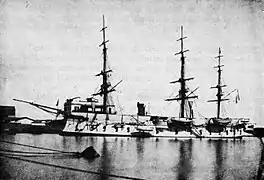 Galissoniére - 1882 - Port Said
Galissoniére - 1882 - Port Said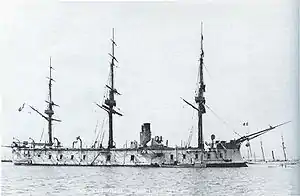 Victorieuse - 1886 - Algiers
Victorieuse - 1886 - Algiers
Barbette ships

Fomidable (11580 tons) next to a war antique Hellenistic-era warship (French: Quinquérème) (no sail power) (550 tons) for perspective visualizations.
- Amiral Duperré (1879) 11,030 tons. Though this ship was designed for sail as well as steam power, her sails were removed before completion.[3] – stricken 1909.[1]
- Bayard class (French: Classe Bayard) 5,915–6,260 tons.[1] Smaller versions of Amiral Duperré, with full sail power.[3]
- Vauban class (French: Classe Vauban) 6,112 tons. Improved Bayards.[1]
- Duguesclin (1883) – stricken 1904.[1]
- Vauban (1882) – stricken 1905.[1]
- Amiral Baudin class 11,720 tons,[1] the first French sea-going battleships without any sail power.[4]
- Amiral Baudin (1883) – hulked 1909.[1]
- Formidable (1885) – stricken 1911.[1]
- Terrible class (French: Classe Terrible) or Indomptable class, 7,530 tons.[1] Small battleships based on the Amiral Baudin, and intended for operating in the Baltic in case of war with Germany.[3] The British sometimes considered these to be sea-going battleships,[5] and sometimes coastal service warships.[2]
- Hoche (1886) 10,820 tons, turrets & barbettes – target 1913.[1]
- Marceau class 10,558–10,810 tons.[1]
- Charles Martel class 10,600–10,650 tons, slightly enlarged Marceaus.[6]
.jpg.webp) Amiral Duperré
Amiral Duperré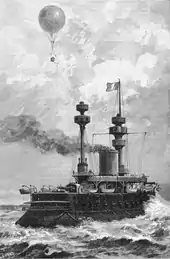 Formidable testing a balloon
Formidable testing a balloon Neptune
Neptune Magenta
Magenta Marceau
Marceau Bayard
Bayard.jpg.webp) A painting by Paul Jazet (1848–1918), featuring a Vauban-class battleship
A painting by Paul Jazet (1848–1918), featuring a Vauban-class battleship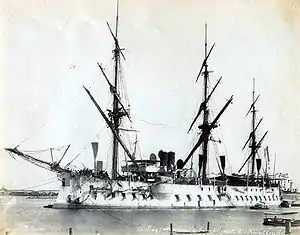 Bayard in Pord Said
Bayard in Pord Said
Floating batteries
- Dévastation class built for the Crimean War 1,600 tons.[1]
- Palestro class 1,508–1,539 tons.[1]
- Arrogante class 1,412-1.490 tons.[1]
- Embuscade class 1,426–1,589 tons.[1]
Casemate ironclad
- Rochambeau (1865) ex-USS Dunderberg 7,800 tons, purchased 1867 – stricken 1872.[1]
Coastal defense ships
- Taureau (1865) barbette ship ram 2,433 tons – stricken 1890.[1]
- Onondaga (1863) ex-USS Onondaga 2,551 tons, purchased 1867 – stricken 1904.[1]
- Cerbère class 3,532 tons.[1]
- Tonnerre class ,1st Class Coastal Battleship, 5,765–5,871 tons.[1]
- Furieux (1883) barbette ship 5,925 tons. Similar to Tonnant for the same reasons.[3] – stricken 1913.[1]
- Tempête class, 2nd Class Coastal Battleship, 4.635-4,793 tons.[1]
- Tonnant (French: Tonnant) (1880) barbette ship 5,010 tons. Originally intended to be similar to Tempête, but redesigned as a small battleship with increased freeboard and a gun at each end in barbettes.[3] – stricken 1903.[1]
- Bouvines class 6,681 tons.[1]
- Valmy class 6,476 tons.[1]
- Henri IV (1899) 8,807 tons – stricken 1921.[1][8][9]
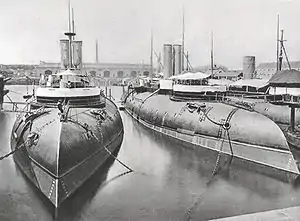 Cerbère and Bélier
Cerbère and Bélier.jpg.webp) Tonnant in 1890
Tonnant in 1890 Henri IV in 1910
Henri IV in 1910
See also
Citations
- Chesnau, Roger and Kolesnik, Eugene (Ed.) Conway's All the World's Fighting Ships, 1860–1905. Conway Maritime Press, 1979. ISBN 0-8317-0302-4
- Brassey, Lord, The Naval Annual 1890, pub Griffin, 1890.
- "Ropp, Theodore, The Development of a Modern Navy, French Naval Policy 1871–1904, pub US Naval Institute, 1987, ISBN 0-87021-141-2
- Hovgaard, William, Modern History of Warships, originally published 1920, pub Conway, 1978, ISBN 0-85177-040-1
- Brassey, Lord, The Naval Annual 1887, pub Griffin, 1887.
- Brassey, Lord, The Naval Annual 1886, pub Griffin, 1886.
- Page 86, Brassey, Lord, The Naval Annual 1886,
- Described as one of the first battleships to utilize turrets in superfiring mode
- In 1920, Henri IV became a TSF school-ship (French: navire-école)
This article is issued from Wikipedia. The text is licensed under Creative Commons - Attribution - Sharealike. Additional terms may apply for the media files.